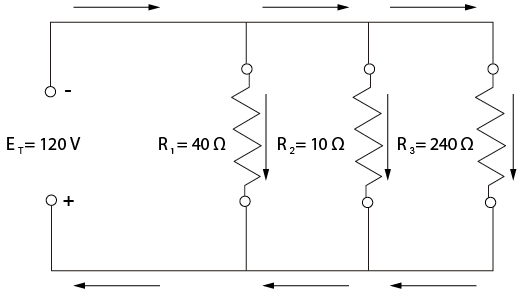2.3: Circuitos paralelos
- Page ID
- 152802
El circuito paralelo (Figura\(\PageIndex{1}\)) tiene características completamente diferentes. En un circuito paralelo, dos o más cargas están conectadas una al lado de la otra y son controladas por uno o más interruptores. Las diferentes cargas pueden tener cada una su propio interruptor, pero la diferencia principal es que cada una de las cargas tiene acceso a la misma cantidad de voltaje y puede operar independientemente de las demás. Hay más de un camino por el que puede fluir la corriente.

saf

\[\begin{array}{l}{\mathrm{I}_{1}=\frac{\mathrm{E}_{1}}{\mathrm{R}_{1}}=\frac{120}{40}=3 \mathrm{amps}} \\ {\mathrm{I}_{2}=\frac{\mathrm{E}_{2}}{\mathrm{R}_{2}}=\frac{120}{10}=12 \mathrm{amps}} \\ {\mathrm{I}_{3}=\frac{\mathrm{E}_{3}}{\mathrm{R}_{3}}=\frac{120}{240}=0.5 \mathrm{amp}}\end{array}\]
\[R_{T}=\frac{E_{T}}{I_{T}}=\frac{120}{15.5}=7.7 \text { ohms }\]
\[R_{T}=\frac{1}{\frac{1}{R_{1}}+\frac{1}{R_{2}}+\frac{1}{R_{3}} \ldots}\]
\[\begin{aligned} R_{T}=& \frac{1}{\frac{1}{40}+\frac{1}{10}+\frac{1}{240}}=7.7 \text { ohms } \\ R_{T}=& \frac{1}{\frac{6}{240}+\frac{24}{240}+\frac{1}{240}} \\ R_{T}=& \frac{\frac{240}{240}}{31} \\ R_{T}=& 7.7 \text { ohms } \end{aligned}\]




